You’ve weighed your options and decided that an exercise bike would be the perfect piece of exercise equipment for your home gym. That’s when you hop online to see what’s available. Immediately, your eyes are bombarded by the best exercise bikes out there, with options from Nordictrack, Echelon, Schwinn, and beyond. Each is different, and they’re all promising to give you the best indoor cycling experience of your life.
It’s a lot to take in — not just the brands and models, but all of the different types of exercise bikes on the market. We’ll slow things down and take you through the kinds of exercise bikes you’ll find in your searches and give you the information you need to decide which type is your type.
Types of Exercise Bikes
Applying a basic definition, an exercise bike is a stationary bike that functions solely as a piece of fitness equipment, as opposed to the mode of transportation it’s based on. Within that definition, there are several types of exercise bikes you can choose from, some of which will be better suited to address your fitness goals than others.
Regardless of the type, BarBend expert reviewer Amanda Capritto recommends you get a bike with a solid warranty that you can also reliably maintain on a consistent schedule. “Review maintenance requirements before purchasing any type of exercise bike, as well as warranty,” she says. “Look for at least five years on the frame, two years on parts, and one year for labor.”
When it comes to lean, mean, cardio machines, exercise bikes rank as top contenders alongside treadmills and ellipticals. Let’s take a look at the different types of exercise bikes and the benefits they can provide in your workout.
Recumbent Bikes
The best recumbent bikes deviate from the upright or forward-leaning nature of most other stationary bikes. The seating position has a prominent recline, and many recumbent exercise bikes position their handlebars on the sides — next to the seat — rather than on the center console.
“The recline angle of the bike makes a difference in the exercise experience,” Amanda explains. “The more upright you are, generally, the more strain on the lower back. However, with a greater recline, you may experience some neck strain depending on where the monitor is located.”
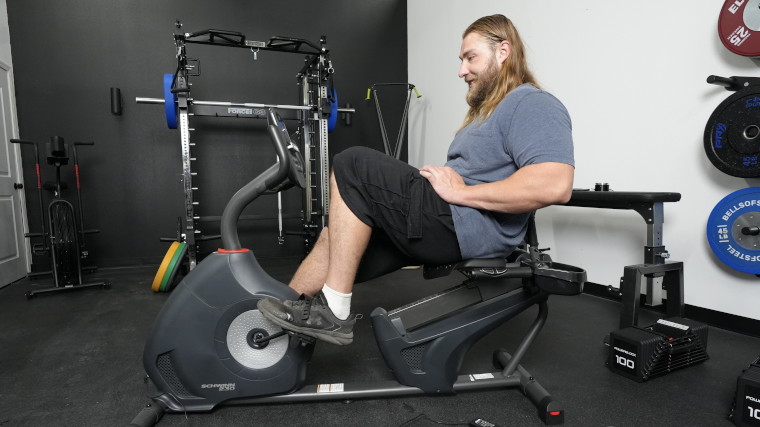
These models also tend to include a lower-profile design and a step-through base that make them much easier to climb aboard than upright bikes, which require you to throw a leg over the frame to get into the seat.
Capritto adds, “Recumbent bikes open up the cycling experience to more people, particularly those with back, hip, or knee issues. The reclined position reduces stress on the lumbar spine and does not require as much flexibility in the hip joints.”

Recumbent bikes can be fairly utilitarian or feature impressive tech capabilities. “You can find simple recumbent bikes with plain LCD monitors that read out stats like time elapsed and estimated calories burned, or you can find recumbent bikes with TV-like touchscreens that stream live workouts and offer a much more interactive experience,” says Capritto. “The latter type costs more money, but is worth it for people who love fitness classes and find them motivating.”
Who Should Use a Recumbent Bike:
- Beginners who want to get accustomed to biking using the basic pedaling movement.
- Physical therapy patients who need to rehabilitate injuries that other bikes might risk exacerbating. (1)
- Those with sore backs, achy joints, or limited mobility in need of a more low-impact form of cycling.
Who Shouldn’t Use a Recumbent Bike:
- Intermediate exercisers hoping to engage more of their body in the exercise than simply their legs.
- Aspiring cyclists who want to emulate the competitive cycling motion of a classic road bike.
Indoor Cycling Bikes
The classic indoor cycling bike is a staple of cycling classes; it’s the model that comes to mind when people picture a spin bike. It also comes the closest to capturing the cycling experience, as it is intentionally designed to position your body like that of a competitive cyclist.
“Indoor exercise bikes provide access to cycling no matter the weather or outdoor conditions,” Capritto points out. “Many people do not feel safe cycling outside. As someone who lived in Miami and trained for triathlons there, riding outside can be brutally terrifying for city dwellers.”

She continues, “There are two distinct camps: Those without giant touchscreen displays, and those with them. Peloton-esque bikes have become ultra-popular among people who love the fitness studio vibes that come from interactive workout sessions, both live and pre-recorded.”
[Read More: Best Exercise Bikes for Small Spaces]
On these bikes, you’re typically able to rise out of the saddle for a more intense ride during virtual studio classes. Some units even come pre-stocked with small dumbbells so that you can add some strength-training into your cardio workout.
“There are two key groups of people I see benefitting from indoor exercise bikes the most: People who need a low-impact way to do cardio exercise, and athletes training for an event who need a way to perform structured interval training,” Capritto says.
Who Should Use an Indoor Cycling Bike:
- Athletes interested in a more realistic cycling experience.
- People who like to take online spin classes, like those you’ll find on the Peloton or iFIT apps.
- Riders looking to turn indoor biking into a weight-bearing exercise and/or group activity that also activates muscles in the upper body. (2)
Who Shouldn’t Use an Indoor Cycling Bike:
- Individuals with leg or back injuries that prevent them from pedaling in an upright position.
- Those with limited mobility who struggle to climb onto an upright bike.
Upright Bikes
An upright exercise bike places you in a vertically elevated seated position, with both the padded seat and the handlebars placed in a higher position than on most exercise bikes. This places your body in a comfortable seated position, but doesn’t support a forward lean or the rider’s ability to rise out of the saddle.
As such, these types of bikes are great for LISS cardio, a type of cardio exercise done at a moderate pace for a longer period of time. This beginner-friendly type of exercise eschews high-intensity intervals in favor of building endurance.
However, Capritto advises, “As wonderful as exercise bikes are, they aren’t for everyone. For people with lower back pain, cycling may exacerbate that due to the positioning of the body on the bike. Seniors and individuals with limited mobility may struggle to get on and off of an exercise bike, in which case a recumbent bike is recommended.”
Who Should Use an Upright Bike:
- Those more interested in LISS than HIIT cardio workouts.
- People who prefer to pedal in an upright position without a forward lean.
Who Shouldn’t Use an Upright Bike:
- Athletes hoping to incorporate more of their body into the exercise than just their legs.
- Those interested in high-intensity interval training.
Air Bikes
The best air bikes are among the purest workout tools. This is because most other types of bikes at least approximate the functionality of an outdoor bike that needs to be steered. That’s not the case with air bikes.
“Air bikes, a type of stationary exercise bike, utilize fan flywheels to create resistance. They are similar to air rowers in that there are no defined resistance levels and the user is completely in charge of the resistance: The harder you pedal, the harder the work becomes,” Capritto says of this unique type of bike.
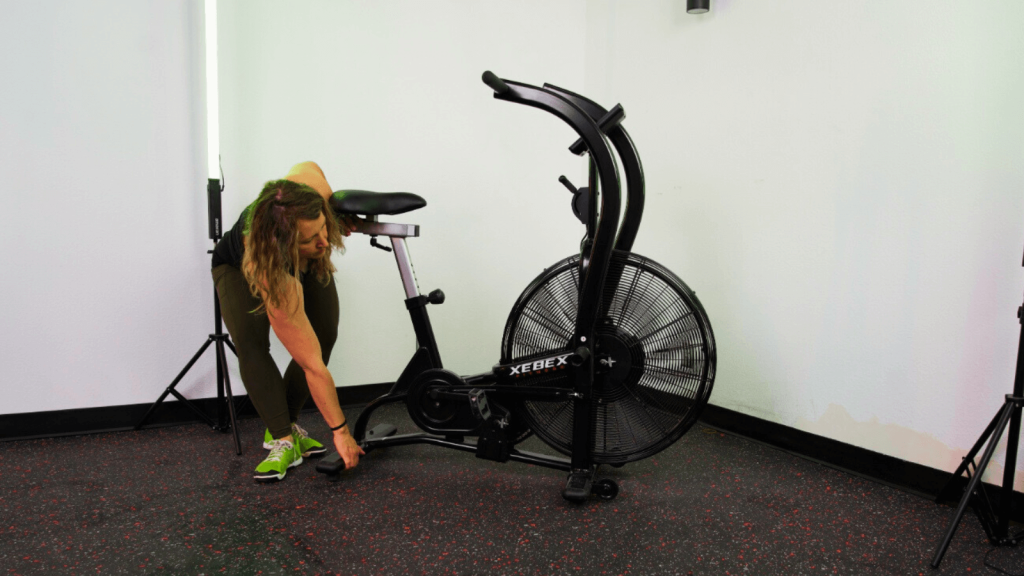
Air bikes also offer a set of resistance arms that allow you to train both the lower body and upper body against air resistance.
“They are great for high-intensity training as well as slow, steady recovery work,” Capritto says. “Compared to regular bikes and indoor bikes, air bikes engage more of the body’s musculature due to the moving arms.”
Popular in CrossFit boxes, air bikes are the most reliable bikes for achieving a full-body workout — and a total-body sweat session — through cardio.
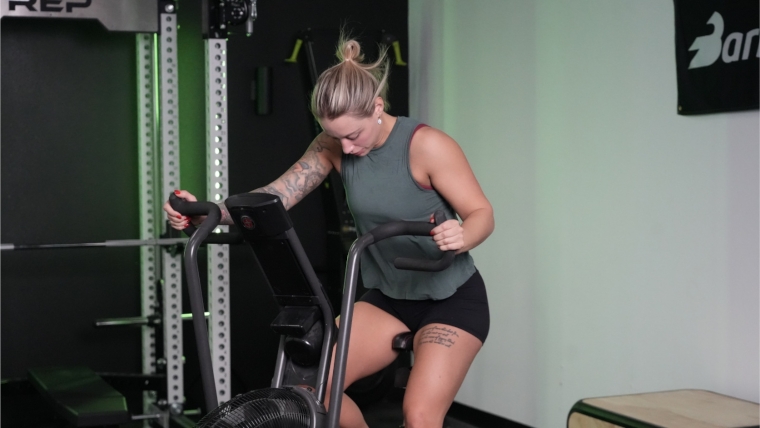
“[They’re] pretty niche, mainly serving the CrossFit community,” says Capritto. “They’re not the right fit for a lot of people; those looking for a high-tech bike with a screen to stream workouts should look elsewhere (specifically into magnetic resistance bikes like those from NordicTrack and Peloton).”
Who Should Use an Air Bike:
- Ambitious riders who like high-intensity interval training and other workouts that require sprinting.
- Athletes who want to aggressively train both their lower and upper body in a time-efficient manner. (3)
- People who want the versatility that comes with having the option to select between an upper-body, lower-body, or hybrid workout program.
Who Shouldn’t Use an Air Bike:
- Individuals who want a more traditional biking experience.
- Those looking for a bike with a built-in screen for streaming virtual spin classes.
- Beginners who may not be ready for the intense workout style necessitated by an air bike.
Folding Bikes
The best folding bikes take on the basic form and function of an ordinary stationary exercise bike, but it is designed to be foldable and easy to store when not in use. This makes it a popular model for those sweating it out in small spaces, whether that be an apartment or a cramped home gym.
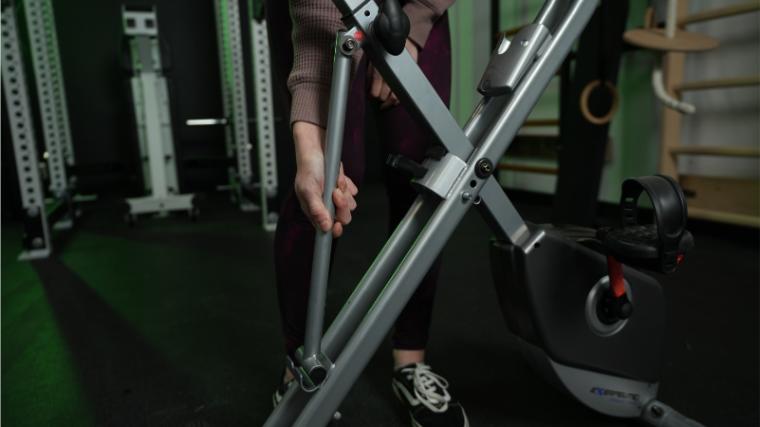
Since they can fold, these bikes tend not to be as durable as traditional models, but they can stand up just fine to low-impact cycling at a moderate pace.
Who Should Use a Folding Bike:
- Those in need of a space-saving exercise bike that they can stow in a corner or closet when not in use.
- People who want a transport-friendly piece of exercise equipment they can bring into an office or rehab facility.
Who Shouldn’t Use a Folding Bike:
- Athletes interested in a durable bike that can stand up to daily HIIT workouts.
- Tech-savvy riders in need of a built-in touchscreen, Bluetooth connectivity, and accurate metrics tracking.
Benefits of Exercise Bikes
The benefits of cycling are mostly universal — regardless of the bike you choose, you’re going to get an excellent workout as long as you’re putting the pedal to the proverbial metal. There are more than enough reasons to lace up your cycling shoes and climb aboard an exercise bike, no matter which one you ultimately select.
Low Impact
Exercise bikes enable you to pedal your way through your workouts in a relatively comfortable, low-impact fashion. This way, you can get your cardiovascular workouts in without your knees absorbing any of the jarring pounding that occurs when your heels strike the moving belt of a treadmill (or, if you’re outside, concrete).
There are also exercise bikes that cater to those with limited mobility. Recumbent bikes are designed with a reclined seat and a step-through base that allows those with back, hip, and knee issues to get their cardio in without aggravating sore joints.
Build Lower-Body Strength
Bike workouts place constant tension on your legs through the act of pedaling, resulting in unrelenting activity in your leg muscles — especially your quads and hamstrings. Most bikes also provide a built-in resistance system that allows you to select from several levels of resistance, allowing plenty of adjustability in the amount of resistance you encounter.
Improve Heart Health
Biking is an excellent cardiovascular exercise, and many exercise bikes will come equipped with an internal heart rate monitor to help you track your heart’s pace and activity level. This is great news for people who want to improve their cardiovascular health and fitness without having to brave either the elements or high-impact training.
Lots of Adjustability
Aside from the ability to adjust resistance directly on the bike, the fact that the movement of the pedals is entirely propelled by your motion means that you have instant control over your workouts.
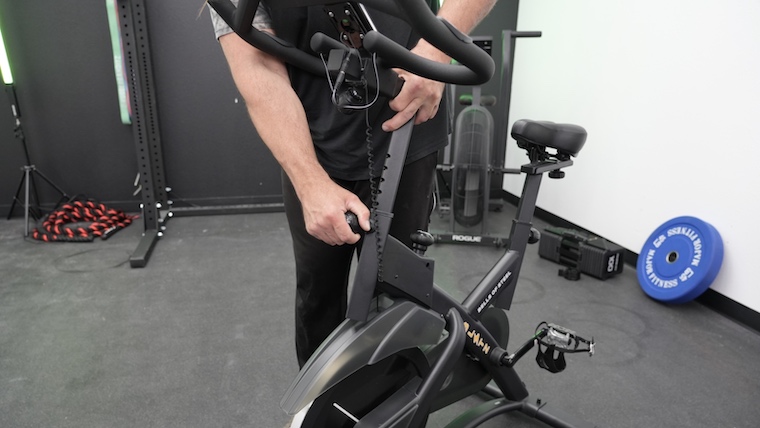
This means that exercise bikes are ideal for high-intensity interval training (HIIT) and other intense workouts that call for you to go all out, quickly slow back down, and then rapidly pick things up again.
Infinite Training Options
Many exercise bikes — like the Peloton Bike — feature built-in touchscreens with on-demand capabilities for delivering workouts from streaming platforms and fitness apps galore. With one of these apps, you can alternate between rides that cater to HIIT and hills training, endurance, recovery, and more. You can even find workouts that incorporate dumbbells into your cardio workout.
Final Word
With several different types of exercise bikes on the market, knowing their unique functions and benefits can help you choose the right exercise bike for you and your needs. Regardless of the type of exercise bike, BarBend expert reviewer Amanda Capritto concludes that, “Cycling brings an impressive collection of health benefits to the table: cardiovascular health, endurance, stamina, muscular endurance are all improved with cycling, to name a few.” It’s no wonder so many consider exercise bikes to be the ultimate cardio machine for weight loss.
If you’re ready to reap all the benefits of an exercise bike, consider your physical limitations, training goals, fitness level, budget or space limitations, and personal preferences to purchase the right bike for you.
Exercise Bikes FAQs
What is the best type of exercise bike?
The best type of exercise bike for you depends on you — your goals, your space requirements, and your budget. Trainees who require the ability to give an all-out, total-body effort might consider an air bike to be the best option. On the other hand, someone with chronic lower back pain might be better served by a recumbent bike.
What are the differences between air, magnetic, and flywheel exercise bikes?
Air bikes gather resistance through fan blades that press against the air. On a flywheel bike, the bulk of the resistance is provided by the weight of a wheel, which is prompted to spin through the act of pedaling. Magnetic resistance is applied to a flywheel by a permanently-inserted magnet, which is usually considered smoother than the resistance offered by a friction-based resistance system.
What are the differences between a spin bike and an upright bike?
A spin bike places its user in the standard cycling posture, with a forward lean. Various lean angles result in differing upper-body muscles being activated during cycling. (2) An upright bike minimizes the leaning of the user, resulting in less stress being placed on the upper body, and isolating more of the tension to the legs.
References
- Said CM, Delahunt M, Hardidge A, Smith P, Tran P, McDonald L, Kefalianos E, Daniel C, Berney S. Recumbent cycling to improve outcomes in people with hip fracture: a feasibility randomized trial. BMC Geriatr. 2021 Jun 29;21(1):394.
- Brand A, Sepp T, Klöpfer-Krämer I, Müßig JA, Kröger I, Wackerle H, Augat P. Upper Body Posture and Muscle Activation in Recreational Cyclists: Immediate Effects of Variable Cycling Setups. Res Q Exerc Sport. 2020 Jun;91(2):298-308.
- Moghaddam M, Cervantes M, Cheshier B, Jacobson BH. Sprint Interval Training on Stationary Air Bike Elicits Cardiorespiratory Adaptations While Being Time-Efficient. J Strength Cond Res. 2023 Sep 1;37(9):1795-1801.